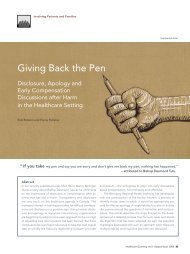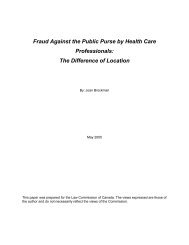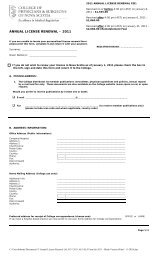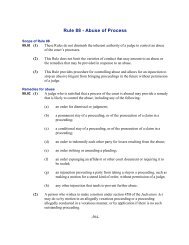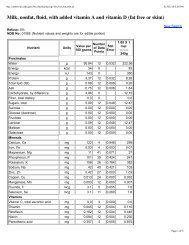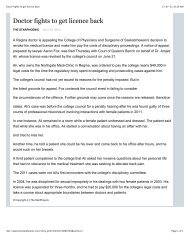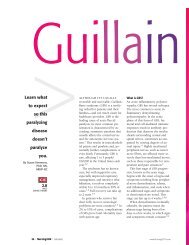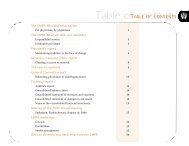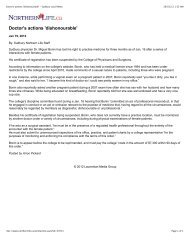Experiments That Changed Nutritional Thinking - TUUM EST
Experiments That Changed Nutritional Thinking - TUUM EST
Experiments That Changed Nutritional Thinking - TUUM EST
Create successful ePaper yourself
Turn your PDF publications into a flip-book with our unique Google optimized e-Paper software.
1046S<br />
SUPPLEMENT<br />
TABLE 1<br />
pairs liver copper storage. Pertinent data from two experiments<br />
are presented in Table 2. All sheep consumed approximately<br />
Liver copper and blood molybdenum concentrations of sheep 10 mg of copper and some were supplemented with 10 mg of<br />
fed different sources of forage supplemented with 10 mg molybdenum per day. When the animals consumed oat hay,<br />
each of copper and molybdenum per day for 6 mo1 the addition of molybdenum had no effect on liver copper<br />
storage, but when they consumed alfalfa it markedly decreased<br />
Dietary forage Increase in Blood Mo copper storage. When the oat hay diet was supplemented with<br />
(chaffed hay) liver Cu2 conc.3 2.2 or 4.4 g of sulfate per day as well as with molybdenum,<br />
copper storage was reduced to the same degree as in sheep fed<br />
mg mcg/100 mL alfalfa supplemented with molybdenum. The lower level of<br />
sulfate (2.2 g) was just as effective as the higher level in de-<br />
Lucerne 9 48<br />
creasing liver copper in sheep consuming oat or alfalfa hay.<br />
Lucerne 3:oat 1 19 96<br />
Lucerne 1:oat 1 35 180 These experiments clearly established the existence of a three-<br />
Lucerne 1:oat 3 70 378 way interaction among copper, molybdenum and sulfate as<br />
Oat 113 447 regards liver copper storage.<br />
In spite of the decrease in liver copper storage observed<br />
1 Adapted from Dick (1952); n Å 6 animals per group. when the diet was supplemented with both molybdenum and<br />
2 The increase in total liver copper is the difference between the sulfate, the concentration of blood copper was increased, as<br />
estimated initial content and that at slaughter; the initial value was<br />
shown by the data summarized in Table 3. The blood copper<br />
approximately 27 mg.<br />
3 The values are the means of weekly blood samples taken over the concentrations rose with increasing levels of both molybdeperiod.<br />
num and sulfate, and there appeared to be an interaction.<br />
Even though the blood copper concentration increased, the<br />
effect as the hay itself. The results summarized in Figure 1<br />
copper was not available for biological function. Sheep fed<br />
show that the administration of potassium sulfate lowered<br />
high levels of molybdenum and sulfate and a nominally ade-<br />
blood molybdenum in a sheep fed oat hay supplemented with<br />
quate level of copper developed signs of copper deficiency even<br />
10 mg of molybdenum per day. The lower blood molybdenum<br />
with blood copper concentrations that were normal or greater<br />
resulted from increased excretion of molybdenum via the kidliver<br />
copper concentration. Clearly, under these conditions of<br />
than normal. There was loss of crimp in the wool and decreased<br />
ney, an effect that was independent of urine volume. This and<br />
related experiments established the Mo-S interaction.<br />
high molybdenum and sulfate intake, blood copper was not a<br />
Subsequently, Dick (1953b) showed that sulfate is also the<br />
valid measure of copper status because there was evidence of<br />
factor in alfalfa that, in combination with molybdenum, imconcentrations.<br />
copper deficiency in spite of normal or elevated blood copper<br />
An explanation of the Cu-Mo-S interaction must account<br />
for the fact that S renders both copper and molybdenum biologically<br />
unavailable and that molybdenum lowers copper<br />
availability only in the presence of dietary S. Suttle (1974)<br />
pointed out that the formation of cupric tetrathiomolybdate,<br />
a highly insoluble complex, could occur in the sulfide-rich<br />
environment of the rumen. This would account for low copper<br />
absorption but not for the high blood copper concentration.<br />
Normally all of the copper in blood is solubilized by trichloroacetic<br />
acid (TCA), but this was not true in cases of high<br />
molybdenum intake. To explain this phenomenon, Dick et al.<br />
(1975) prepared di, tri- and tetrathiomolybdates and observed<br />
that their addition to blood in vitro resulted in a TCA-insoluble<br />
fraction that contained most of the copper. When tetrathiomolybdate<br />
was administered to sheep intravenously, there<br />
was an immediate rise in the TCA-insoluble copper in the<br />
blood. Thus, formation of copper thiomolybdates, particularly<br />
CuMoS 4 , in the rumen accounts for the poor absorption of<br />
copper when the intake of molybdenum is high. The absorption<br />
of thiomolybdate and subsequent formation of CuMoS 4<br />
in the blood accounts for the high concentration of blood<br />
copper that is not bioavailable.<br />
The experiments described here revealed a three-way interaction<br />
of copper, molybdenum and sulfate in ruminant animals,<br />
in which bacterial fermentation plays a major role in<br />
digestion. The interaction in monogastric animals is much less<br />
dramatic, because there is less sulfide available to form the<br />
thiomolybdate complexes. Ruminal microflora normally play<br />
FIGURE 1 Effect of a single oral dose of potassium sulfate on<br />
a major role in this three-way interaction, but the interaction<br />
the blood concentration (mcg/100 mL) and urinary excretion (mg/d) of<br />
molybdenum. The sheep was fed oat hay and drenched daily with 10 can be demonstrated in monogastric animals by administration<br />
mg of Mo as ammonium molybdate. Collections were made over 7 d; of thiomolybdates. Interestingly, tetrathiomolybdate has been<br />
the time of sulfate administration is indicated by arrow. Figure 4 from used to treat Wilson’s disease in human patients (Brewer et<br />
Dick (1953a).<br />
al. 1994). This genetic disease results in accumulation of cop-<br />
/ 4p09$$0062 04-07-97 14:02:12 nutras LP: J Nut May Suppl<br />
Downloaded from jn.nutrition.org by on June 3, 2010



